Papua New Guinea is a fascinating region, even for those who are not interested in coffees – rich history, unique cultures, unparalleled biodiversity, and isolation from world markets have made this young nation truly unique. Nowhere else on earth will we find the same combination of ancient traditional life-ways with the chaos and opportunity brought by rapid modernization.
For coffee fans, mysterious PNG is even more enchanting due to its offerings of many uncommon and delicious beans. In 2017, Jon made a trip to PNG to visit some of our favorite estates and learn about the challenges and benefits that come with their unusual approach. He met lots of lovely kind people and was surprised by huge differences in culture and agriculture.
In brief, a lush tropical climate combined with high mountain ranges encourage an enormous diversity of “micro-climates” and create a land with unparalleled cultural and biological diversity. The Highlands region is perfectly placed to provide the ideal conditions for growing coffee. But the complex and peculiar sociopolitical situation in PNG makes effective, profitable coffee farming very challenging. Life is so very different than what we know in the West that it requires a lot of explaining to really accurately paint a picture of it – this article will highlight just a few of the most notable characteristics of the “Wild West of coffee production.”
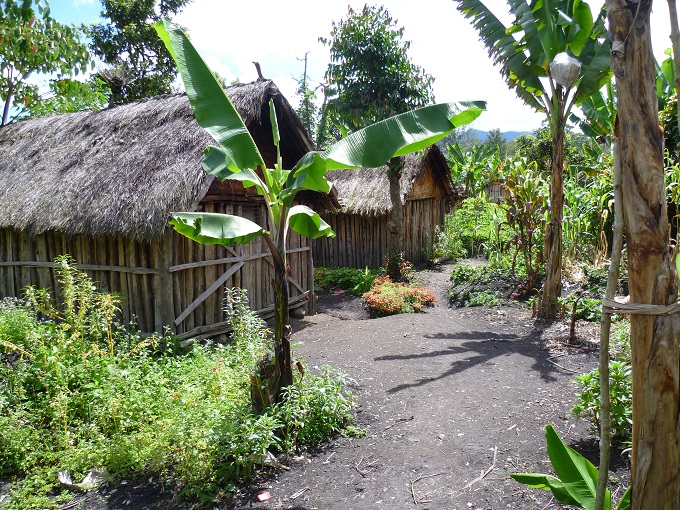
These houses (Sigri Estate) are much nicer than the
accommodations of many Papuans
Papua New Guinea was, until 1975, a neglected colony controlled by Australia. The entire island (which is now half PNG, half Indonesian provinces of Papua and West Papua) was a battleground for European colonial powers in the 19th century, until 1905 when the Brits kicked out other European settlers and turned over control of the territory to the Commonwealth of Australia. It was also the site of intense conflict between Japanese and Australian troops during World War II. But preceding and outlasting these colonial histories are the indigenous peoples who have inhabited the island for millennia – their ancestors were some of the first humans to journey out of Africa, and their cultures are some of the most ancient in the whole world.
With the backing of the UN, Papuans appealed for and gained independence in 1975, but it remains a part of the British Commonwealth system and is heavily dependent on Australian aid money for industrial development and public services. Throughout the ’80s and ’90s uprisings and civil war plagued Papuans as they struggled to find their place in the world.
Today, although traditional practices of head-hunting and ritual cannibalism have virtually disappeared, other forms of violence remain – PNG ranks very low on indexes of human rights and violence against women, and vigilante murders of “sorcerers” are not uncommon. Public education is woefully inadequate and illiteracy rates are extremely high.
On the other hand, PNG is unequaled in beautiful dense diversity, with over 1000 distinct cultures speaking over 800 languages. Many of these communities still practice traditional ways that are rarely seen anywhere else on earth. It is considered a “megadiverse” region because of the incredible numbers of unique endemic species. Wild food grows everywhere; banana trees sprout up like weeds.
It is also abundant in many natural resources, and exports of raw materials (gold, copper, petroleum, palm oil, tuna, etc) make up the majority of the economy. This fact in itself has led to many of the difficulties that Papuans face, as almost all of the corporations engaged in extraction are of foreign origin and do not seem to care much about their impacts; scientists predict that well over half of PNG’s rainforests will be destroyed by 2025.
One way in which Papuans have attempted to alter the legacy of colonization is to establish a system of “customary land title.” Only a tiny fraction of the land is held by private property owners; about 97% of the country is considered to belong to the indigenous inhabitants, and passed on to future generations by their traditional methods. This interesting concept can lead to big challenges; there are constant and unending arguments over who has the primary rights to any given piece of land. And as you might imagine, denying the right to private property makes it pretty tricky to run a coffee estate!
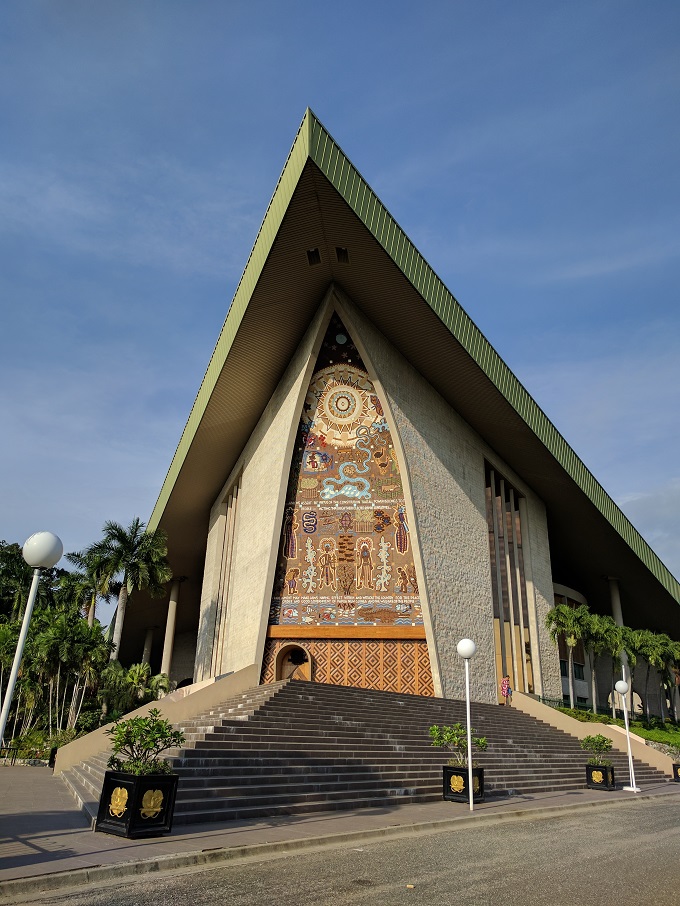
The Parliament is one of the fanciest buildings in
Port Moresby
Today, even the most impoverished developing nations have at least a few modern-looking cities. Papua New Guinea has just one, the capitol Port Moresby, pop. 300,000. Port Moresby has one shopping mall, one movie theater, and a handful of expensive hotels catering to tourists. All of these have been built in the last 10 years, giving a sense of how extremely isolated PNG has been. The city has well-maintained roads and some tall buildings, but is conspicuously non-Western in appearance; everything is locked down and gated, most houses and buildings are surrounded by tall walls, and security guards search cars and send pedestrians through metal detectors just to get into an ordinary restaurant. Police are notoriously corrupt and appear to spend most of their time harassing people at random in hopes of extorting bribes.
With the exception of a few foreigners, nearly everyone who lives in Port Moresby has left traditional village life to seek economic opportunity, most of them walking for many days just to get there, and only able to visit home once or twice per year. Most of these folks feel blessed to have clean water and electricity, amenities almost unheard of as recently as the ’70s, even though their lives may appear very hard-scrabble and destitute by Western standards. Jon observed that the mall and the movie theater are extremely popular – hundreds of people go there just to hang out and watch the hustle and bustle, even though they do not have enough money to purchase anything.
Rural PNG is another story entirely. Just getting to any location other than Port Moresby is a hefty challenge, because roads are incomplete and very poorly constructed. There are a couple of major highways connecting Port Moresby to other nearby economic centers, but beyond that it is typical to find roads that just end suddenly or disappear into enormous potholes. Adventurous travelers may find success traversing in a 4×4 truck, but they won’t get anywhere quickly! Most tourists who want to visit other areas do so in chartered bush planes. About 85% of Papuans live in tribal villages and practice traditional subsistence agriculture. They walk anywhere they need to go, and most of the time they have no incentives to travel outside of their familiar territory, especially given the potential for violence from other tribes with ancient rivalries.
Most of the premium coffee coming from PNG originates in the Highlands region, a mountainous spine stretching the length of the island. The Highlands are astoundingly abundant, covered in tropical cloud forests and relatively dense human populations.
A foreign visitor may be surprised and disturbed to see that nearly all of the trucks (no cars can handle the Highlands “roads”) are customized with thick steel bars welded across every window, sometimes even the windshield. But locals will reassure them that it is really not that bad – petty crimes and opportunistic thefts are just an accepted part of daily life in impoverished places, and relatively minor security precautions will discourage most anyone with devious intents.
Traditional village life is easy to witness in the Highlands; the main highway out of the city of Mount Hagen is dotted with clusters of humble houses and tiny local restaurants and pubs. Areas with more dense populations may have ramshackle flea markets, but stores as we think of them are non-existent. Most of the vendors have tiny rustic fruit and vegetable stands, plus a few racks of cheap clothes made in China hanging out in the sun. There are very few other industrial products beyond the most essential tools. Often, locals gather along the roadside and get great entertainment from watching traffic puttering by. For some, the one road snaking through their village may be their only exposure to the outside world. In fact, PNG is known to have numerous “uncontacted peoples” and there are still many settlements that have no roads whatsoever.
The climate in the Highlands is enviable, about 70-80° F every day, all year round. Proximity to the equator ensures consistent warmth, while the altitude keeps it from getting too hot. Seasonal concepts like spring, summer, autumn, and winter have no place in PNG; it is just Dry or Rainy. For those unfamiliar with tropical weather patterns, this can be hard to imagine. Basically, between November-March it rains every day, and the rest of the year it is sunny every day. We can’t even imagine weather conditions more different than what we get here in Wisconsin!
The combination of perfect temperatures and perfect altitudes create conditions in which coffee trees have an unbroken endless growing season, and they yield flowers, fruits and beans 365 days a year!
Almost all PNG coffees undergo standard washed processing, making them significantly different than neighboring Indonesian coffees, which use a special local processing method. PNG fans rave about their coffees’ sweetness, often describing them as bright, syrupy or “full-bodied,” with notes of honey, melon, or cocoa.
On the other hand, many PNG coffees may be unpredictable or a little rough. This is because almost all of them are processed and bagged in aggregate mills, which do not engage in cultivation at all. At one point, there were a number of coffee estates in the Highlands, but most lost their property rights when Papuans gained independence and insisted on reducing foreign control of their lands. When the “customary land title” policy was implemented, many European settlers just gave up and returned to their motherlands – but the coffee trees remained.
So now, most coffee harvesting is done by enterprising individuals who wander the Highlands rainforests and pick any ripe coffee cherries that they may find. Estate owners complain that they must constantly defend their crops from thieves who sneak in late at night and cart off as much as they can carry.
Due to lack of expertise, many of these “coffee foragers” pick far too many under- or over-ripe beans, just grabbing whatever they come across until their pick-up truck is overflowing. Truckloads of freshly picked cherries line up outside of aggregate mills every single day, and foragers are paid pennies per pound. This is justified by saying that the quality is low and that the mill workers are forced to spend countless hours screening out under- or over-ripe cherries, but we can’t help but wonder… if the mills paid people better, maybe they would try harder to do a good job?
Regardless, at the end of the day, coffees coming out of these aggregate mills are very mixed up – many different varieties coming from many different locations – and they can be inconsistent and sometimes intense, edgy. For some, this is part of what makes PNG coffees exciting, but for others it is unappealing.
The good news for our coffee connoisseurs is that there are a handful of estates which have managed to hold onto control of their lands, and these professional operations are practicing stringent quality-control measures and producing reliably outstanding beans that we love.
Supervised by expert coffee producers, the mills on the professional estates have a very effective streamlined process, beginning with the “wet milling” stage that sorts out the obviously bad beans and any sticks or debris. Then the fruit is stripped off and clean beans soak in spring water for 12-36 hours to loosen any remaining fruit. Fancy pressure washers are used to fully wash the beans more quickly and efficiently than the channel systems that are used by most processors. After this, beans dry on patios until they reach the ideal 12% moisture, then go through “dry milling” to remove parchment and to be sorted by size. A final step that is uncommon in other countries is to employ a large staff of real people (not automated machines) to closely inspect everything and pick out any remaining defected beans. This very precisely-controlled process leads to coffees that are clean, consistent, and far superior to many other coffees coming out of PNG.
One of the farms with which we work closely is called Kimel Estate. In the heart of the Wahgi Valley (one of only 3 locations where the sensitive Blue Mountain cultivar can grow), this smaller estate is noteworthy for its indigenous ownership – it was purchased from the Australian founders by a coalition of local tribes in 1979 – and its pursuit of sustainability through recycling of wash water and composting fruit/pulp into fertilizer.
The Carpenter Estates Group oversees three different farms – Sigri, Bunum Wo, and Kindeng – also located nearby in the Wahgi Valley. We have another article highlighting everything that we love about this awesome exceptional coffee producer.
We highly encourage our customers to try premium Papua New Guinea coffees. From megadiverse rainforest origins to sweet and sparkly cup profile, PNG coffees are unique and exciting, and the “Wild West of coffee production” may be the next frontier for intriguing and delicious boutique beans.
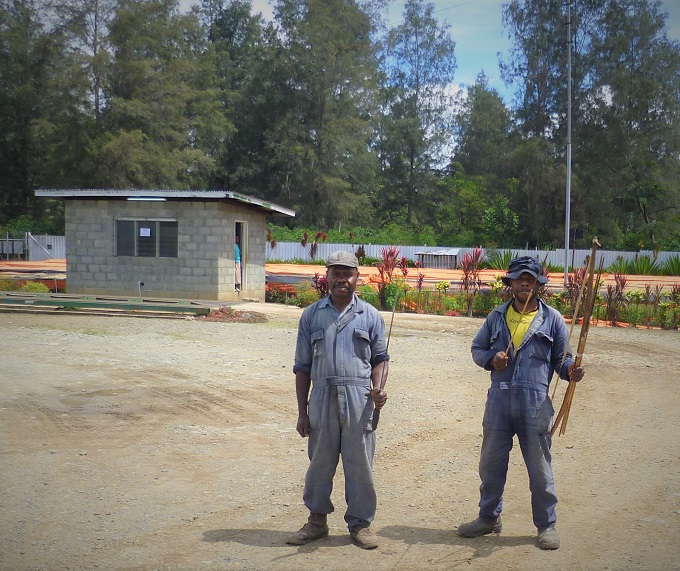
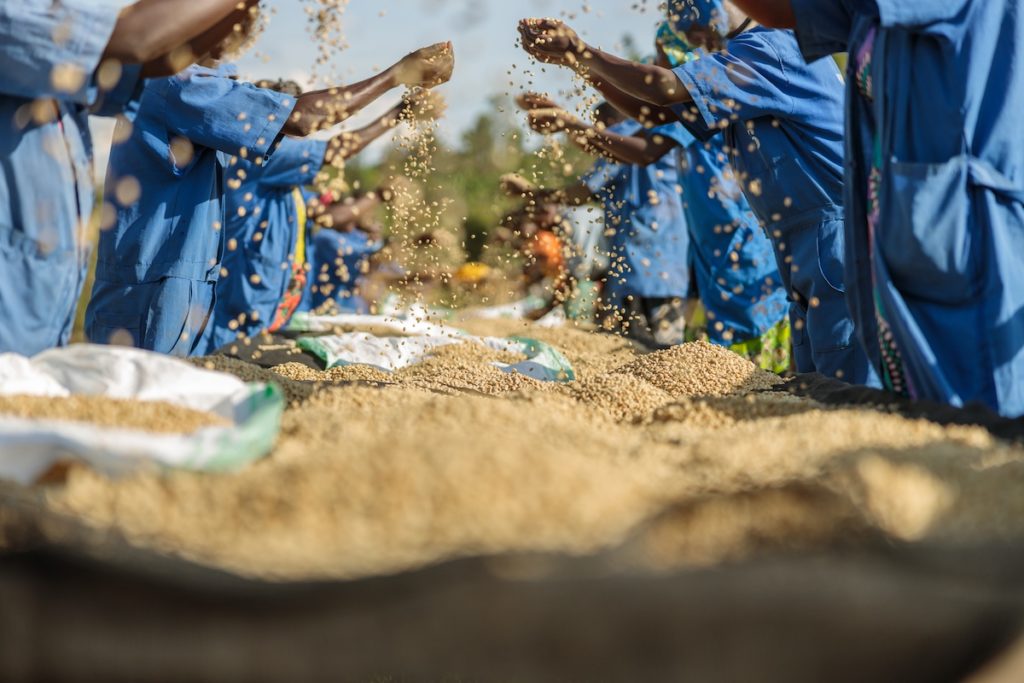
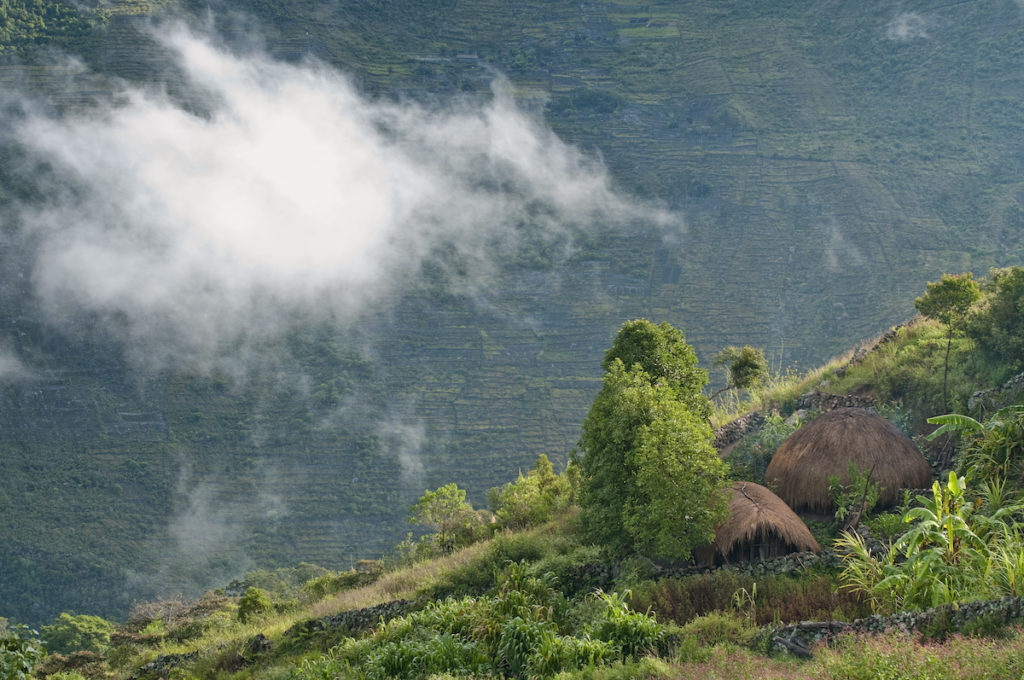

One thought on “Papua New Guinea – The Wild West of Coffee Production”